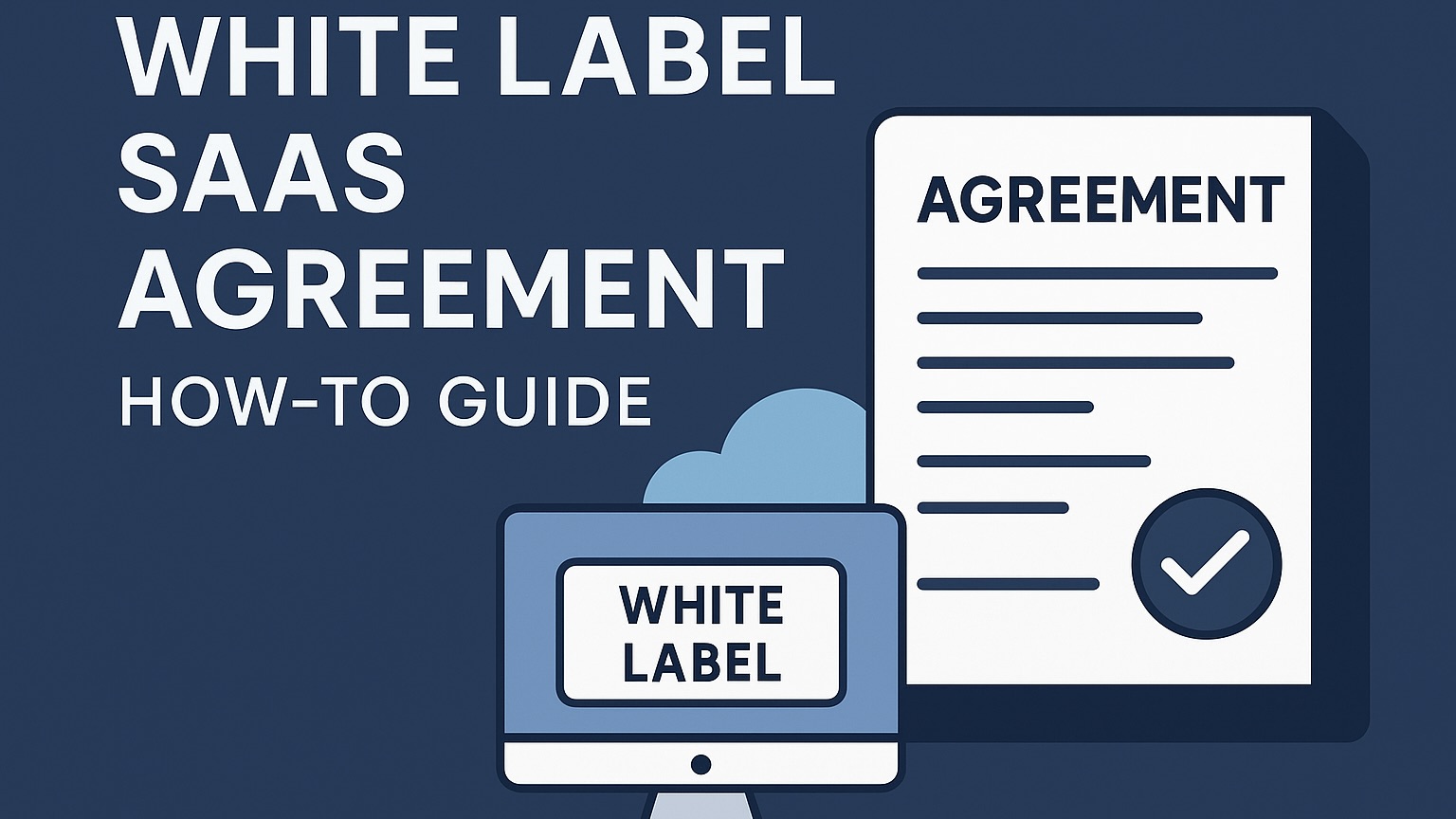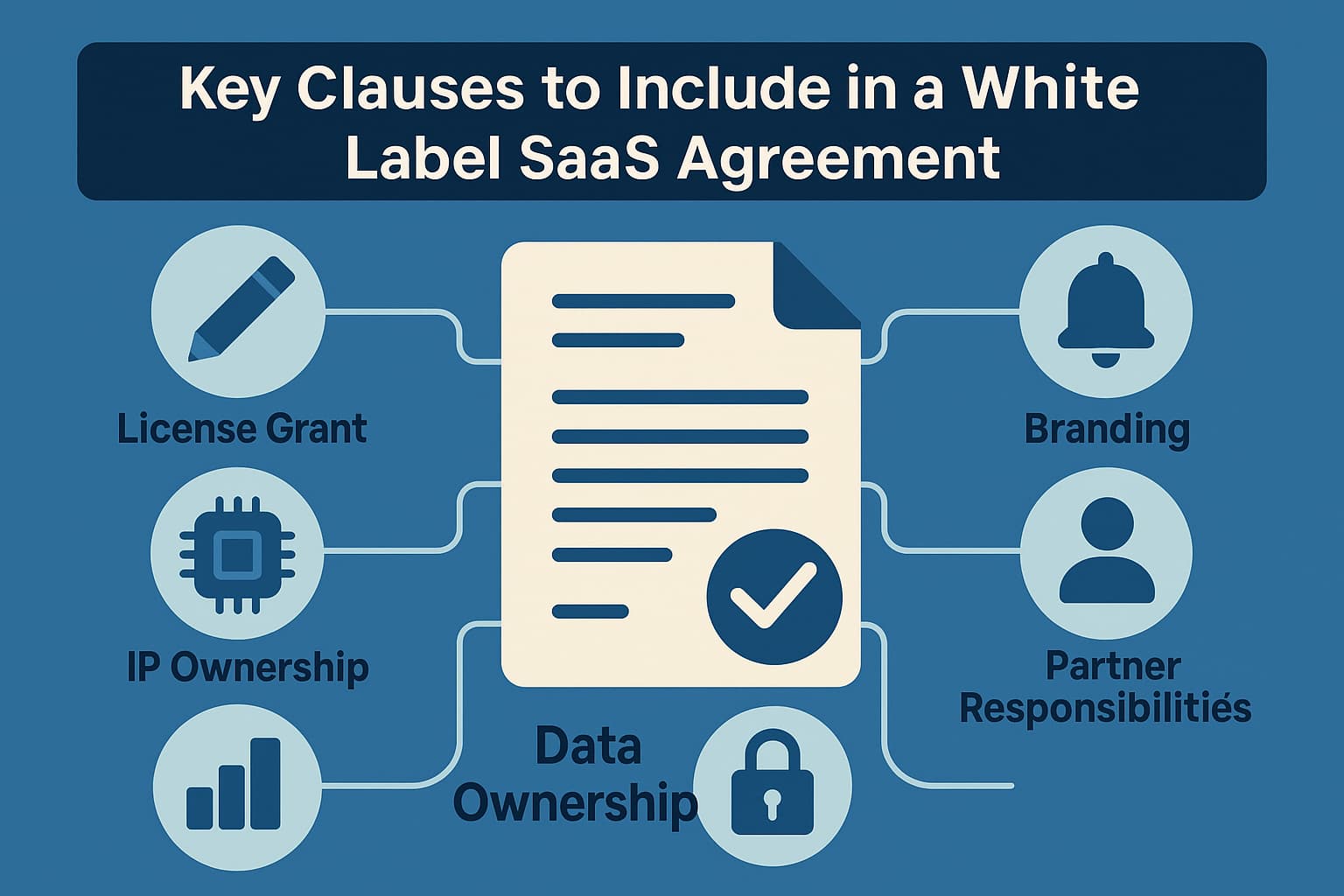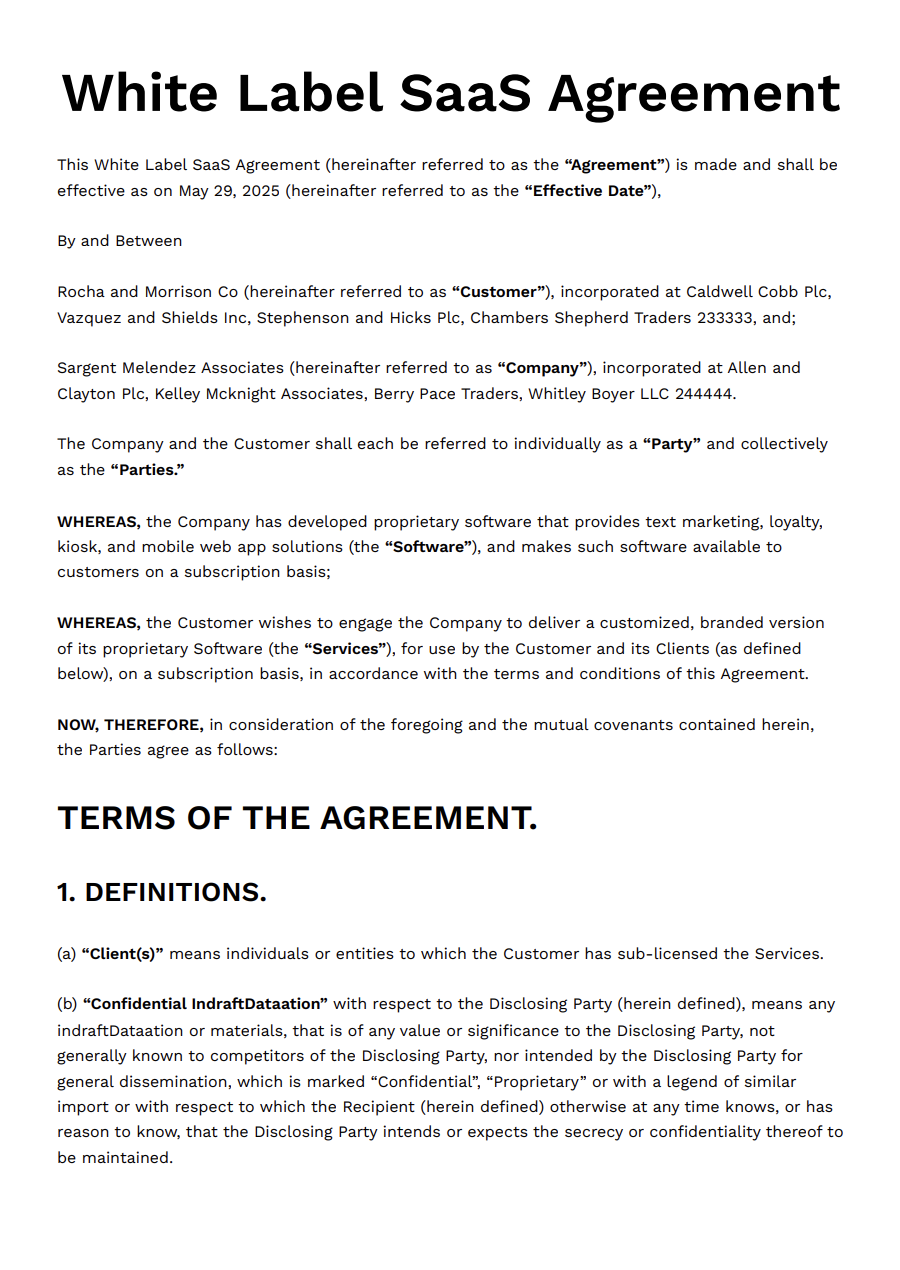What is white label SaaS agreement? 2025 complete guide

Table of Contents
- 1. Introduction
- 2. Understanding White Label SaaS
- 3. Key Clauses to Include in a White Label SaaS Agreement
- 3.1 Definitions
- 3.2 License Grant
- 3.3 Branding and Customization
- 3.4 Ownership and Intellectual Property
- 3.5 Partner Responsibilities
- 3.6 Pricing and Payment Terms
- 3.7 Service Level Agreement (SLA)
- 3.8 Data Ownership and Privacy
- 3.9 Term and Termination
- 3.10 Indemnification and Liability
- 3.11 Dispute Resolution
- 4. Tailoring the Agreement for Different Scenarios
- 5. Common Mistakes to Avoid
- 6. Templates and Legal Tools
- 7. Conclusion
1. Introduction
1.1 What Is White Label SaaS?
White Label SaaS is a software solution created by one company but rebranded and sold by another. The original creator builds and maintains the product. The partner adds their own brand and presents it as their own. This allows companies to offer complete software without building it themselves.
1.2 Why Is a Specific Agreement Necessary?
This kind of setup involves many shared responsibilities. The software owner must protect their technology. The partner must respect brand rules, support users, and follow legal terms. A clear agreement avoids problems by setting rules for both sides.
Without a solid contract, you risk confusion over who owns what, who supports users, and how money is shared. A strong agreement protects your product, brand, and business.
1.3 Purpose of This Guide
This guide is made for:
- Startup founders offering white-label options
- Legal teams preparing contracts for partnerships
- Indie developers selling branded versions of their tools
You’ll learn how to create an agreement that covers your rights, protects your product, and supports good business.
2. Understanding White Label SaaS
2.1 Definition and How It Works
White Label SaaS is a type of software that one company builds and another company sells under its own name. The software is still hosted and managed by the original creator, but the customer sees the partner’s brand.
For example, a company that makes project management software can allow other businesses to resell it with their own logo and domain name. To users, it looks like a tool made by the reseller, but the backend remains the same.
2.2 Key Differences from Standard SaaS
Compared to regular SaaS, white-label software has special rules:
| Standard SaaS | White Label SaaS |
|---|---|
| Provider sells directly to users | Partner resells under their brand |
| Branding stays the same | Branding is changed by the partner |
| Users know the software creator | Users may not know who built the product |
Because of this, white label deals need clear agreements about who controls what.
2.3 Common Use Cases
White label SaaS is popular in many industries:
- Reselling: A marketing firm resells SEO tools as part of its package
- OEM partnerships: A company includes white-label software in its hardware offering
- Co-branded platforms: Two companies share the software but apply their own logos
Each case brings different legal needs. That’s why a custom agreement matters.
3. Key Clauses to Include in a White Label SaaS Agreement

3.1 Definitions
This section lists key terms so both sides agree on their meaning. Important terms may include:
- White Label Product: The software offered under the partner’s brand
- Partner: The company reselling or branding the product
- End Users: The people or companies who use the branded software
- Branding: Visual elements like logos, colors, and domains used by the partner
Clear definitions help avoid confusion later.
3.2 License Grant
This clause explains what the partner is allowed to do with the software:
- Can the partner resell it to others?
- Are there limits on who they can sell to?
- Can they change anything in the product?
It also lists what the partner is not allowed to do, like copying or reverse-engineering the software.
3.3 Branding and Customization
This part explains how the partner can brand the product. It includes:
- What can be changed (logos, color themes, custom domains)
- What cannot be changed (layout, core user experience)
The goal is to protect the product’s core look and feel while allowing enough freedom for rebranding.
3.4 Ownership and Intellectual Property
This clause protects the software creator’s ownership. It should say:
- The provider owns all parts of the original software
- The partner does not get any ownership rights
- Custom features made for the partner may still belong to the provider unless stated otherwise
It also covers copyright, trademarks, and code usage.
3.5 Partner Responsibilities
This section outlines what the partner must do. Common duties include:
- Selling the product honestly
- Providing first-level support to their end users
- Following legal rules and branding guidelines
This protects both parties from user complaints and poor service.
3.6 Pricing and Payment Terms
This clause explains how the partner pays the provider. It includes:
- Licensing fees or revenue share details
- How and when payments are made
- What happens if payment is late
Clear money rules reduce billing issues.
3.7 Service Level Agreement (SLA)
This defines the service quality. It often includes:
- How much uptime is promised (e.g., 99.9%)
- Support hours and response times
- What the provider will do if the service fails
An SLA helps set fair expectations.
3.8 Data Ownership and Privacy
This part explains who owns the data and how it is handled:
- The partner or end user usually owns their data
- The provider is responsible for protecting it
- Privacy rules like GDPR or CCPA must be followed
This clause is key in markets where data protection is a legal requirement.
3.9 Term and Termination
This clause covers how long the agreement lasts and how it can end:
- Contract start and renewal periods
- Rules for early cancellation
- What happens to user data if the deal ends
This protects both sides if things change.
3.10 Indemnification and Liability
This part explains legal risk-sharing. It usually includes:
- Each side agrees to cover the other’s losses if they cause a problem
- Limits on how much each side can be held responsible for
This keeps legal risk under control.
3.11 Dispute Resolution
This clause explains what happens if there is a serious disagreement:
- Which laws apply
- Where legal claims must be made
- Whether arbitration or court is used
This helps avoid long, unclear legal battles.
You can generate a white label SaaS agreement in under 15 minutes with our easy-to-use contract builder.
4. Tailoring the Agreement for Different Scenarios
4.1 Adjusting Terms by Industry
Not every white label setup is the same. Some industries have strict rules, so your agreement should match those needs.
For example:
- Healthcare: Must follow laws about patient data and system reliability
- Finance: Needs stronger security and clear terms on data ownership
- Education: May require rules about student privacy and content usage
Make sure your contract includes any special legal terms required in your target industry.
4.2 Levels of Integration
Not all white label deals are fully branded. Some partners only change the logo, while others want deeper control. Your agreement should match the level of customization.
Basic White Label:
- Partner only changes brand visuals
- Provider keeps control over features and updates
Co-Branded or Joint Development:
- Partner may help build new features
- Agreement must include who owns those features
- More legal and business coordination is needed
By setting clear limits and roles, you avoid later arguments about who controls what.
5. Common Mistakes to Avoid
5.1 Ambiguity in IP Ownership
One of the most serious mistakes is not clearly stating who owns the software and any new features. If this part is unclear, it can lead to legal conflict.
Always state that:
- The provider owns the core product
- Any custom changes belong to the provider or are licensed clearly
- The partner only gets rights to use and resell, not to claim ownership
5.2 Failing to Restrict Partner Behavior
Some agreements forget to set limits on what the partner can do. This can cause issues like:
- Poor customer support damaging your brand
- The partner reselling to restricted markets or groups
- Violations of branding rules
Be sure to include clear guidelines on how the partner should act and what they must avoid.
5.3 Overlooking Data Security and Compliance
When your partner handles user data, you are still responsible in many cases. If your agreement does not set clear rules about data handling, privacy laws like GDPR or CCPA could be violated.
To avoid this:
- Define who owns the data
- Explain how it must be protected
- Require the partner to follow all privacy laws
These steps help protect both your users and your business.
6. Templates and Legal Tools
6.1 Recommended Agreement Templates
If you’re starting from scratch, using a trusted template can save time and reduce mistakes. Here are a few options:
- Juro: Offers simple contract automation with templates
- SaaSGree: Contract builder tool, including SaaS contract templates
- Docracy: A free collection of startup-friendly legal documents
Use these as a base, but always customize the terms for your specific product and partner setup.
6.2 Tools for Contract E-Signing
Once your agreement is ready, you’ll need a way to send and sign it. These tools help you manage everything in one place:
| Tool | Main Use |
|---|---|
| DocuSign | Reliable electronic signatures |
| HelloSign | Easy for teams to manage documents |
| Contractbook | Full contract lifecycle management |
These tools make it easier to track, sign, and store agreements without delays or confusion.
6.3 When to Consult a Legal Professional
Even if you start with a template, it’s wise to have a lawyer review your final agreement. A legal expert can:
- Check compliance with local laws
- Spot unclear or risky language
- Help with IP, data, and partner rights
For large or long-term deals, legal review is strongly recommended.
7. Conclusion
A clear White Label SaaS agreement protects your software, your brand, and your business. It sets the rules for how your product is used, how it is sold, and how each party must act.
This type of partnership can be a great way to grow your product’s reach without extra sales or marketing work. But without a strong agreement, it can lead to confusion, lost revenue, or legal problems.
Always treat a white label deal as a real business contract. Use clear terms, cover data rights, define ownership, and set limits. Tailor the agreement to each partner’s needs, and when in doubt, get legal help.
You can generate a white label SaaS agreement in under 15 minutes with our easy-to-use contract builder.
